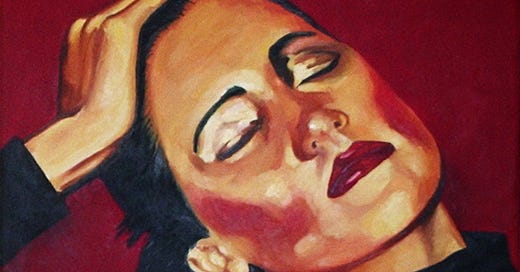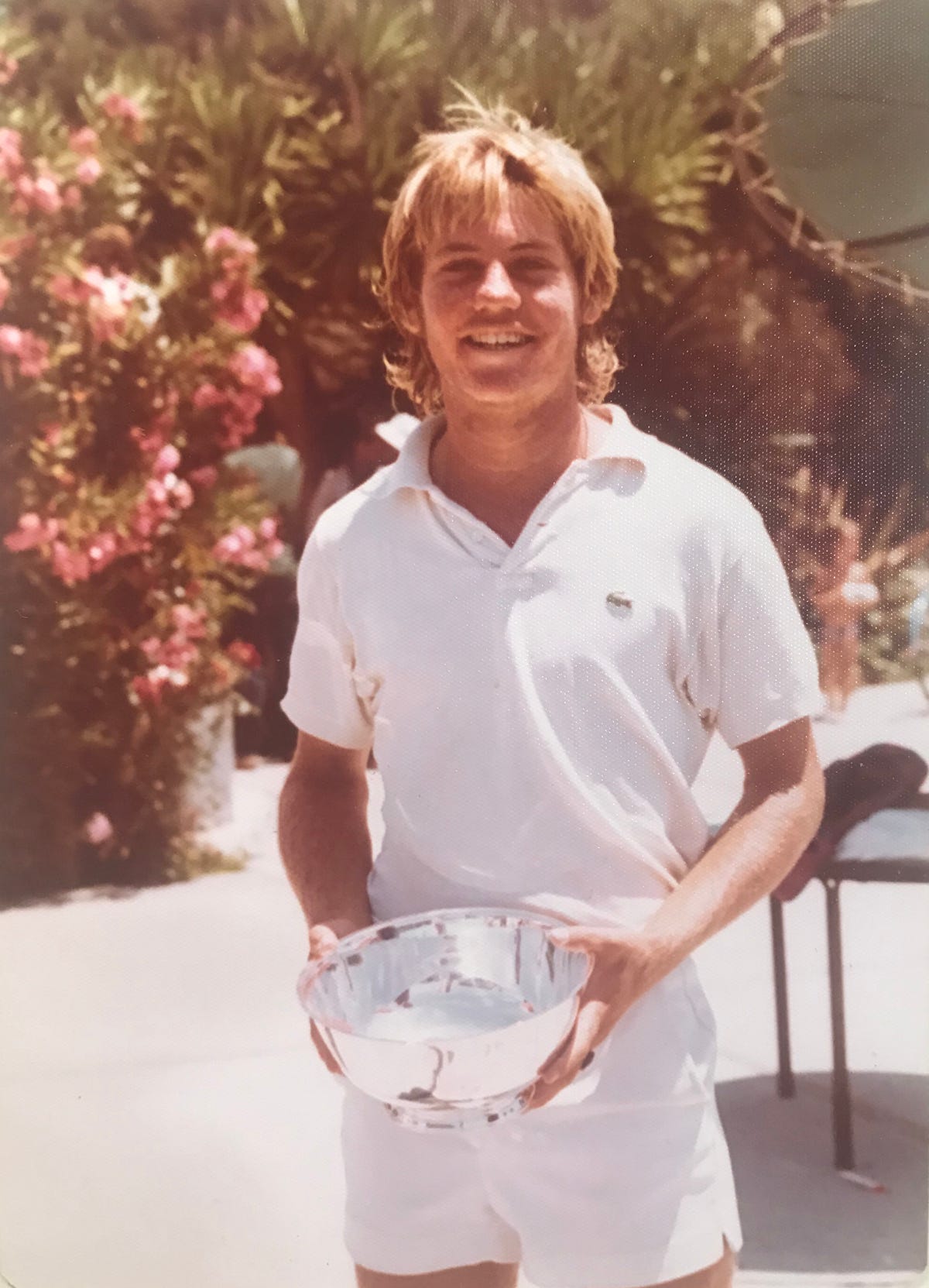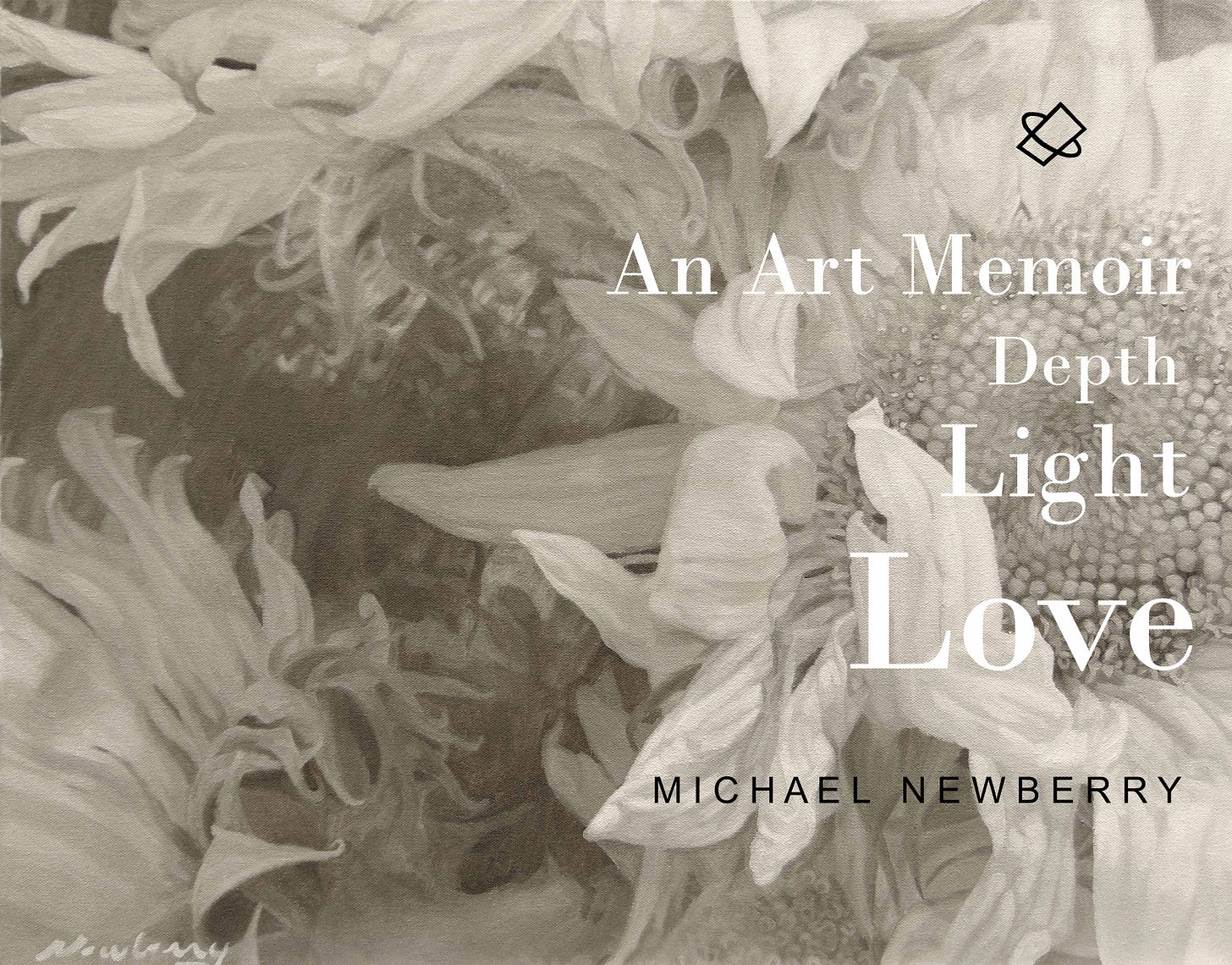7 Fifi, 1975, oil on canvas, 48x48”. One of my earliest surviving works.
In 6th grade (11 years old), one student forgot his math book and got to do his art project instead of math. Later, on walking home after school, I deliberately ditched my math book under a dense pine tree. For the next week, I was in heaven because I worked on my art project instead of math. I vividly recall that it was a mixed media sculpture made from a wood branch, string, and yarn, resembling a colorful spider's web. Possibly influenced by the television series The Addams Family and the colorful hippies invading California beaches.
The following week, the teacher had my math book in her hand; someone found the book and returned it to the school. She looked puzzled, but seeing how despondent I was recognizing my math book, figured I ditched it on purpose. That afternoon, she said to me, “Michael, you are always going to float through life.” Thoughtlessly she was calling me a loser, but considering that I would do anything for art, conveyed the opposite: that I was driven. My silent thoughts were how insane it was to treat all topics equally, and how could I not have a preference?!
The contrast between her and Coach Stoefen was pronounced. I am sure she did her best, but I doubt she knew I was appraising her in comparison to a world-class athlete/coach. If she had known, I imagine she would have rethought her assessment of me. It was inevitable that school would be painfully boring, and I ditched class every chance I got. In hindsight, I would have liked to learn other topics, but it wasn't going to happen if I didn’t feel inspired.
In both tennis and art, I continued to pursue them with pure focus and dedication. I got tremendous pleasure from them and I wanted to fully realize my gifts for their own sake. I didn’t care for much else, except I still loved driving. At fourteen, I took my sister’s car (she was away on the Virginia Slims pro tennis tour) and drove roundtrip from La Jolla to Julian, an old gold-mining town in the mountains 60 miles away.
I had a shameless disregard for conventional rules imposed by my parents, teachers, and the law—I simply followed my non-conformist path. It's somewhat paradoxical, as it didn't mean I was unethical; rather, I never cheated in tennis and always embraced the challenge of solving art problems, both of which I enjoyed and prided myself on.
My daily schedule between 12 and 17 years old was to play tennis two to four hours, depending on remaining daylight, and then I would do art projects at night. Unfortunately, all my art from those years is lost.
I mourn the loss of one drawing in particular: an ink sketch of a nighttime interior of our modern living room with its massive 10x8’ windows. The interior furnishings were dimly reflected in the windows, creating a sense of shadowed alter egos. There was also an added layer of complexity as the olive tree beyond the windows intertwined with the ghost-like reflections. Even today, that project would be optically very challenging. It would have been great to still have it, as it foreshadowed my current Space Series with its abundance of transparencies, 53 years later.
8 Here I am as the California State Junior Champion in 1974.
In tennis, I was one of the top junior players in the United States, and as a 17-year-old, I was the California State Junior Champion, pictured smiling holding the championship bowl. You can’t see the conflict in my face, but in this tournament, while in the middle of competing on court, I was constantly debating with myself about tennis vs. art. I thought about how mentally and spiritually challenging painting was compared to the simpler tennis mindset. Then I would remind myself to shut up and focus 100% on tracking the ball and meeting it early in the space between me and the net. But then a voice would inconveniently pop up, asking what I wanted in life, while driving a forehand winner down the line. Crazy!
That summer before starting college, I finished in the final eight in two US National Junior Championships (Burlingame and Kalamazoo). I also defeated the great junior player Howard Schoenfield at the clay court nationals in Louisville. As a result, I gained a full tennis scholarship to the University of Southern California, my first choice. USC boasted one of the top three college tennis teams in the nation, led by the stellar coach George Toley, who had won 10 NCAA Championships. I also sold my first artwork for $200! Additionally, I chose to major in fine art and studied under the guidance of the wonderful modernist artist Edgar Ewing – he was the best!
After my first year of college, I had a solo art show at a La Jolla bank, showcasing my portrait Fifi. It was an excellent art venue, with its huge lobby and abundant wall space. The opening drew many friends and families.
Fifi is one of my earliest surviving works, measuring 48x48"—a monumental portrait of a childhood friend as a young adult. Her face radiates the golden warmth influenced by Rembrandt.
It's worth noting that figurative art wasn't taught in college.
GEORGE TOLEY
Toley was a very kind man, a great tennis tactician, and one of the coolest customers I have ever met. In the 3 years I played on the team, one of which we won the NCAA Team Championships in 1976, he never lost an argument with a tennis official or other coach. One of his insights was that if you break your opponent’s serve, on the changeover take the full 1-minute time of rest. He observed that when you rush, your opponent can hotheadedly make up the lost ground, but if you slow him down, he stews, feels inadequate, and then you calmly take charge of your lead and win the psychological war. He also used the similar technique for when you were losing or not playing well—always keep your winner’s timing and posture, and before you know it the tide turns to your favor. These tactics helped me gain tremendous knowledge about body language, that I have used every day in painting since then.
EDGAR EWING
Ewing was such a lovely man. He always had joy and delight in everything related to art. He was knowledgeable about technique, themes, artistic integrity, and how to make art come alive. One day during class, I was working on a still-life of animal bones, jars, glasses, and fabrics. As I carefully finished the piece, he suggested that I make the front bone more powerful. I went back to it, attempting to do so, but nothing special happened. Then, he asked for my painting palette, walked over to the canvas, dipped his thumb into the titanium white paint, and simply applied a glob of it to the end of the bone. It was like magic; the whole painting came alive, transforming all the work I had done into sparkling vibrations of color. He must have enjoyed how astonished I was by that powerful gesture.
Ewing also empathetically understood how I felt about art and knew it was a very powerful force that could drive me for the rest of my life. And he did his damnedest to nurture it, and I felt he was 100% in my corner.
An interesting contrast between Toley and Ewing was that tennis and art had different natures. Toley was a brilliant coach, but coaching is a kind of thankless job in the sense that if the player loses, the coach will blame himself, but if the player wins, it is the player’s victory. As a teenager, I could run circles around Toley on the court; his tennis days were long over. On the other hand, Ewing was at the top of his game as an artist, while I still had so much to learn and master. This begged the question: what do I want to be as an old man? A weathered wrinkled public park tennis instructor or be celebrating a lifetime of artistic achievements?
KEVIN ROBB
Even in my freshman year I knew I would not aim for a degree, and I didn’t need one. I would either be an artist or a professional tennis player. I did fill up my curriculum with art studio and art history classes, but for an elective I chose a 401 philosophy class, Pre-Socratic Thought taught by Kevin Robb. It was an honor that he let me as a freshman take an advanced senior course, and amusing in the sense that I could barely spell “cat!”
Kevin talked and looked a lot like William F. Buckley Jr., and he loved lecturing. He did it with wit and tremendous confidence, bordering on bravado. Amazing since he was lecturing about archaic philosophy. Everyone had the sense that he was the cleverest person in the room, intellectually generous, and emotionally supportive—and insanely inquisitive in a Socratic way. I was to find out that not only was he a scholar, but he was also good enough to participate in Olympic skiing tryouts. So we had a common bond of the duality of high-level sport with art and philosophy.
He seemed to be very well off, with a two-story pad literally on the beach in Venice Beach, and he drove a new Porsche Carrera. Once he asked me to go to the Hollywood Bowl and let me drive. I had expected the Porsche to drive smoothly like a Cadillac Seville, instead, it felt more like driving a go-cart; every single dimple in the road felt like a thud, and the acceleration pedal took much more physical effort. I figured out that the designers wanted it to be an intense physical road experience. He had been invited to the Bowl to join John Hospers at his box, with me as a guest.
Hospers, a philosopher and contentious friend of Ayn Rand, had been the 1972 Libertarian candidate for President of the U.S. It was just the three of us, and you would think the conversation would have been memorable, especially with Hospers's expertise in aesthetics, but it wasn’t. On the drive back, Kevin couldn’t help but gossip about Hospers’s “friends” running off with his silverware.
There was something incongruous about Kevin. He was a vivacious character, yet he is only known for a few scholarly and obscure articles on ancient Greek passages. Though he hinted to me that he was the anonymous author behind the anonymous author behind the bestselling penname, Trevanian. The Eiger Sanction being the most famous book.
This made sense as the fictional Dr. Jonathan Hemlock, character matched Kevin’s in important ways: both were scholars, one a specialist in ancient Greek philosophy, and the other in art history; and both engaged in alpine events, one a competitive skier, and the other a mountaineer. An unknown was that the fictional Hemlock funded his expensive art collection as an counter intelligence operative. The few scholarly articles Kevin wrote were sparse output for a philosophy professor. Did he write just enough academic pieces to maintain a front?
This was in the middle of the infamous Cold War, a period when the CIA was saturated with aesthetic intellectuals embedded all over the cultural landscape. Was Kevin an agent, receiving payment through covert anonymous book sales? It does seem plausible. Kevin had also taught in Istanbul, and when combined with his beach pad, Porsche, flamboyance, and razor-sharp psychological detection, he seemed more like James Bond than an obscure intellectual.
The nerdy scholars I know are mostly absent-minded researchers with no star quality. I did some snooping and found out that a recluse, Rodney William Whitaker, supposedly was the anonymous author of The Eiger Sanction. I mentioned this to Kevin, and he replied that having additional levels of subterfuge was convenient. It could have been true, and it made a lot of sense from what I had closely observed of his character.
Before I left college, I had a frank talk with Kevin. I asked him directly, “If indeed you were the writer behind Trevanian, why didn't you simply come out with it? Be transparent about it?” He remained silent and didn’t reply. There was definitely something furtive that I couldn't comprehend as a teenager. And that was the last communication we ever had. It really didn’t matter if it was true or if he was a pathological liar; it showed that my pursuit of authenticity and truth would eventually weed out the disingenuous.
Art Is Like Making Love
The greatest lesson I learned in my life came from Ewing’s mantra: Art is like making love. I took that to heart, pouring 100% of my body, spirit, and focus into each of the thousand-plus artworks I've created. Ewing's second lesson was equally profound: Make art you love and do something else to make money.
Up through college, I hadn’t yet faced a choice between tennis and art; they had been complementary activities. But I had begun to notice my limitations in tennis. No matter how hard I would work, I would never be the best—i.e., top ten in the world. Thankfully, in art, my progress continued to grow exponentially, almost effortlessly, no matter how much I challenged myself.
Tennis training was physically brutal, and art constantly demanded more of my time. Something had to give. Without the pain of my childhood moral dilemma, I took time to think about the choice between the two. As I mentioned earlier, in tennis, the physical window closes quickly after 30, but in art, the window is open until death! The problem is that early dedication is crucial to both. I couldn’t give the next 10 years to professional tennis and hope to excel at art. I’d be in my 30s starting Art 101. With my mind and heart clear, I opted for art.
I gave Coach Toley my notice that I would not come back for the final year of school. And he graciously said if I wanted to come back a year later my sports scholarship would still be available.
After I told Ewing, he made an announcement to our art class congratulating me on the enormity of pursuing an art career uncompromisingly. I was kind of embarrassed, but I felt honored.
Not yet 20, I would prioritize my art education and use tennis as a means of income. Meanwhile, I was off to Europe to play the minor pro circuit and make plans for attending a real art school in the fall. Next stop, the land of Rembrandt: Holland.







Michael, you had some fabulous guiding lights leading you to be an incredible artist. It seems their inspiration ignited your talent and passion for all that you live for and love.
Jonathan, my ex named himself after the character Jonathan Hemlock. He really got into that character. He was obsessed with him. Coincidence you mentioned the Eiger Sanction.
Continue to stay magical! 💫💞💫
Thank you so much. Beautifully written and it almost made my cry to hear about these wonderful teachers you had. Cry, because I didn't have them and all my life I had this nagging feeling that I never really lived my full potential.
I also envy your courage to not allow anyone to have your wings clipped as a child and teenager.
I am thankful to you that you pointed out that certain pursuits are suitable for old age and until death, and others are not. While this is somehow obvious, it re-foccussed me and encouraged me to put even more attention and love ("Make art like you are making love" - how wise and beautiful) to the one big passion that still drives me: The practise of non-dual spirituality (Advaita Vedanta). And I will aplly the above love maxine to it. Now, thinking about it, I think that is one very important missing piece in my spirituality: Not enough love.
How wonderful that you, being blessed with great teachers, unknowingly and probably unintentionally, taught me something really important just know. Thank you so much. I am looking forward to more of your writings. I also really enjoyed looking at Fifi.